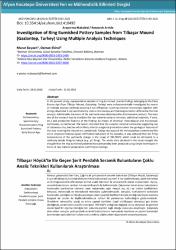Investigation of ring burnished pottery samples from Tilbaşar Mound (Gaziantep, Turkey) using multiple analysis techniques
Künye
Bayazit, M. & Ekinci, O. (2019). Investigation of Ring Burnished Pottery Samples from Tilbaşar Mound (Gaziantep, Turkey) Using Multiple Analysis Techniques . Afyon Kocatepe Üniversitesi Fen Ve Mühendislik Bilimleri Dergisi , 19 (1) , 193-202 . DOI: 10.35414/akufemubid.410495Özet
In the present study, representative samples of ring burnished ceramic findings belonging to the Early Bronze Age (from Tilbaşar Mound, Gaziantep, Turkey) were archaeometrically investigated by means of multiple analysis methods covering X-ray diffraction, scanning electron microscopy together with energy dispersive X-ray spectrometry, optical microscopy and thermogravimetric-differential thermal analysis. Additionally, the colors of the potsherds were determined by chromametric analysis. The main aim of the research was to elucidate the raw material content (minerals, additional materials, if exist, etc.) and production features of the findings by means of chemical, mineralogical and microscopic techniques, as mentioned. The results indicated that the samples comprise carbonates suggesting use of calcareous clay batches which likely refer to a regional production (when the geological features of the area covering the mound are considered). Taking into account the mineral/phase content and the micro structural features (poor vitrification behavior) of the samples, it was deduced that the firing temperatures of the potsherds change in the range of 700-900oC which could be attributed to a relatively simple firing technique (e.g. pit firing). The whole data obtained in the study brought the thought that the ring burnished potteries have presumably been produced using simple techniques in terms of raw material preparation and firing technology. Mevcut çalışmada Erken Tunç Çağı’na ait şerit perdahlı seramik buluntular (Tilbaşar Höyük, Gaziantep) X-ışını difraksiyonu, taramalı elektron mikroskobu/enerji saçınımlı X-ray spektroskopisi, optik mikroskop ve termogravimetrik-diferansiyel termal analiz teknikleri ile arkeometrik olarak incelenmiştir. Ayrıca, seramik buluntuların renkleri kromametrik analiz ile belirlenmiştir. Çalışmanın temel amacı buluntuların hammadde içeriklerinin (mineral, ilave malzemeler; eğer mevcut ise, vb.) ve üretim özelliklerinin kimyasal, mineralojik ve mikroskobik metotlarla aydınlatılmasıdır. Sonuçlar, numunelerin karbonatlı hammadde içerdiğini ve höyüğü çevreleyen alanın jeolojik özellikleri dikkate alındığında büyük olasılıkla bölgesel bir üretim ile ilişkilendirilebilecek kalkerli kil yataklarının kullanıldığını göstermektedir. Örneklerin mineral/faz içeriği ve mikro yapısal özellikleri (zayıf vitrifikasyon davranışı) göz önüne alındığında, seramiklerin pişirim sıcaklığının 700-900oC aralığında değiştiği ve bu durumun da göreceli olarak basit bir pişirme tekniğine (ör, çukurda pişirim) bağlı olduğu sonucuna ulaşılmıştır. Çalışmada elde edilen sonuçlar şerit perdahlı seramik buluntularının hammadde hazırlama ve pişirim teknolojisi bakımından basit teknikler kullanılarak üretilmiş olabilecekleri düşüncesini ortaya koymuştur.
Kaynak
Fen ve Mühendislik Bilimleri DergisiCilt
19Sayı
1Koleksiyonlar
- Cilt 19 : Sayı 1 [31]



















